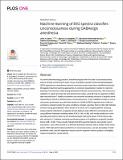Machine learning of EEG spectra classifies unconsciousness during GABAergic anesthesia
Author(s)
Abel, John H; Badgeley, Marcus A; Meschede-Krasa, Benyamin; Schamberg, Gabriel; Garwood, Indie C; Lecamwasam, Kimaya; Chakravarty, Sourish; Zhou, David W; Keating, Matthew; Purdon, Patrick L; Brown, Emery N; ... Show more Show less
DownloadPublished version (2.121Mb)
Publisher with Creative Commons License
Publisher with Creative Commons License
Creative Commons Attribution
Terms of use
Metadata
Show full item recordAbstract
<jats:p>In current anesthesiology practice, anesthesiologists infer the state of unconsciousness without directly monitoring the brain. Drug- and patient-specific electroencephalographic (EEG) signatures of anesthesia-induced unconsciousness have been identified previously. We applied machine learning approaches to construct classification models for real-time tracking of unconscious state during anesthesia-induced unconsciousness. We used cross-validation to select and train the best performing models using 33,159 2s segments of EEG data recorded from 7 healthy volunteers who received increasing infusions of propofol while responding to stimuli to directly assess unconsciousness. Cross-validated models of unconsciousness performed very well when tested on 13,929 2s EEG segments from 3 left-out volunteers collected under the same conditions (median volunteer AUCs 0.99-0.99). Models showed strong generalization when tested on a cohort of 27 surgical patients receiving solely propofol collected in a separate clinical dataset under different circumstances and using different hardware (median patient AUCs 0.95—0.98), with model predictions corresponding with actions taken by the anesthesiologist during the cases. Performance was also strong for 17 patients receiving sevoflurane (alone or in addition to propofol) (median AUCs 0.88—0.92). These results indicate that EEG spectral features can predict unconsciousness, even when tested on a different anesthetic that acts with a similar neural mechanism. With high performance predictions of unconsciousness, we can accurately monitor anesthetic state, and this approach may be used to engineer infusion pumps to intelligibly respond to patients’ neural activity.</jats:p>
Date issued
2021Department
Picower Institute for Learning and Memory; Massachusetts Institute of Technology. Department of Brain and Cognitive Sciences; Harvard University--MIT Division of Health Sciences and TechnologyJournal
PLoS ONE
Publisher
Public Library of Science (PLoS)
Citation
Abel, John H, Badgeley, Marcus A, Meschede-Krasa, Benyamin, Schamberg, Gabriel, Garwood, Indie C et al. 2021. "Machine learning of EEG spectra classifies unconsciousness during GABAergic anesthesia." PLoS ONE, 16 (5).
Version: Final published version